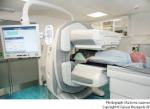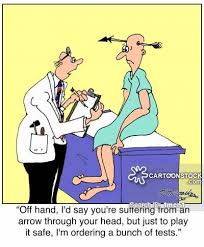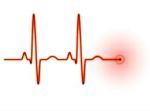Is Your Doctor Ordering Unnecessary Tests? 7 To Watch For
Introduction by Bob Aronson
Dr. Priscilla Diffie-Couch, regularly sends out health, fitness and medical tips and ideas to family members and some friends. She is highly regarded as a resource, and an amazing researcher with a knack for cutting through the medical terminology and making it understandable. In our family it is not uncommon to hear, “Priscilla says…..” and that makes it gospel.
Today I received this email from her:
“INAPPROPRIATE TEST ORDERS INUNDATE HEALTH SYSTEM”
From Priscilla Diffie-Couch
That was the headline in one of my health sources today. They cited three health tests that are misused frequently:
- Test for healthy vitamin D levels. The correct test is called 25-dehydroxyvitamin D test. The incorrect test ordered more often than not is called 1,25-hidroxyvitamin D test. Note the 1 and the comma in front of the wrong test (designed to detect renal failure) plus the “I” instead of an “E” in the word dehydroxyvitamin. Of course, you who read my health notes have known the correct test to request for several years now.
- Test for anemia by determining levels of B12. The older you are, the more questions you need to ask about the lab standards that apply to your B12 test results.
- Ionized calcium tests are overused and do not tell you if you have a shortage of calcium.
Upon reading Priscilla’s email I wondered what other tests might be unnecessary so I did some quick internet research and found plenty. Here’s my quick intro followed by a report from AARP.
-0-
Physicians are among the most trusted people on earth. When a Doctor orders a CT scan or an X Ray or even a blood test few of us think to question her. We know she has completed several years of medical school and for many of us it is unthinkable to question that kind of expertise.
But – question we must because physicians regularly order unnecessary tests and those tests can negatively affect the patient in two ways; 1) it could well be money out of your pocket either in higher medical bills (An MRI, or magnetic resonance imaging scan, can cost $1,000 or more), increased co-pays or more costly insurance and; 2) the tests could be dangerous. Ordinary X-rays are rarely a concern, but super-sharp X-rays called CT scans involve relatively large radiation doses and can raise the risk of cancer. And So, you might ask, “Why would they order tests they know are unnecessary? Is it because they are afraid of lawsuits?” Good question, and lawsuits are part of the answer. Professional pride is another. Like us, doctors don’t like being wrong either.
As suggested, the most commonly cited reason is “defensive medicine”: the fear of being sued by  patients for not ordering a test. An American Academy of Orthopedic Surgeons study that involved 72 orthopedic surgeons who saw over 2,000 patients reported ordering 20% of their expensive imaging tests “for defensive reasons.” Included was 57% of bone scans, 53% for ultrasounds, 38% for MRIs, 33% for CT scans and 11% for x-rays.
patients for not ordering a test. An American Academy of Orthopedic Surgeons study that involved 72 orthopedic surgeons who saw over 2,000 patients reported ordering 20% of their expensive imaging tests “for defensive reasons.” Included was 57% of bone scans, 53% for ultrasounds, 38% for MRIs, 33% for CT scans and 11% for x-rays.
Those unnecessary and overused tests account cost the American patient upwards of $60 billion a year. That’s a whole lot of hard earned money, but fear of lawsuits alone is not the prime motivator. The leader is something most people have never heard of. It’s called the M & M conference (Morbidity and Mortality). That’s where you stand up in front of your peers and “fess up” to your mistakes. Needless to say, that can be quite embarrassing. The M & M conference, though, is a double edged sword because while it is unlikely the physician will ever make that mistake again, it is very likely they will order more unnecessary tests because they are good insurance against another M & M visit.
With that background here is a summary of 7 tests that may be unnecessary. Tests you should ask about when you are scheduled for any of them. AARP did a fine job of assembling this information along with the dangers the tests present and the exceptions that can be made for having them.
7 Medical Tests and Treatments You May Not Really Need
Think twice before getting these procedures
by: Elizabeth Agnvall, AARP
The American Board of Internal Medicine Foundation (ABIM) asked nine medical societies — from family doctors to allergists and cardiologists — to each identify five commonly used medical tests and treatments that are often unnecessary. A list of 45 overused procedures was presented Wednesday, April 4, 2012, at a news conference at the National Press Club in Washington, D.C.
from family doctors to allergists and cardiologists — to each identify five commonly used medical tests and treatments that are often unnecessary. A list of 45 overused procedures was presented Wednesday, April 4, 2012, at a news conference at the National Press Club in Washington, D.C.
“We’re changing the culture in medicine,” says Christine K. Cassel, M.D., president of the ABIM, about this new Choosing Wisely campaign, which represents some 375,000 doctors. Consumer Reports also has joined the doctors’ campaign.
Related
- What tests and screenings do you need if you are over 50? Read
- Understanding lab test results. Read
- Clean out your medicine cabinet. Read
“Too much testing is being done that isn’t needed, that doesn’t work,” says John Santa, M.D., who directs health ratings for Consumer Reports.
Here are seven of the most popular, most overused tests and treatments for people over age 50 that the AARP Bulletin has selected from the Choosing Wisely campaign. For the complete list go to www.choosingwisely.org.
American Academy of Family Physicians
These can be lifesaving for those experiencing chest pain or other symptoms of heart disease. But a 2010 Consumer Reports survey found that 44 percent of people with no signs or symptoms of heart diseasehad an EKG, an exercise stress test or an ultrasound. For several years, cardiology guidelines have discouraged heart screening tests for people who have no symptoms and are not at high risk, and yet their use “is more common than it needs to be,” says James Fasules, M.D., an official with the American College of Cardiology. For those at low risk for heart disease, an EKG or cardiac stress test is far more likely to show a false positive result than find a real problem.
Dangers: False positive tests often lead to more tests and even invasive heart procedures.
Exceptions: If you have diabetes or other conditions that raise your risk, talk to your doctor. Use this calculator to find out your 10-year risk of having a heart attack.
2. Bone scans for osteoporosis for women under 65 and men under 70 with no risk factors.
risk factors.
American Academy of Family Physicians
Bone density decreases and the risk of fractures increases with age, but medical experts say that most women don’t need a bone density test until age 65. Still, many doctors recommend the scan starting at age 50.
Dangers: Bone density (DXA) scans can lead to unneeded medications that can have serious side effects.
Exceptions: Talk to your doctor about a scan before age 65 (70 if you’re a man) if you were or are a smoker; you’ve used steroid medications regularly; have low body weight; or have already had a fracture. ThisFRAX tool can help you calculate your risk.
 3. Antibiotics for mild-to-moderate sinus infections.
3. Antibiotics for mild-to-moderate sinus infections.
American Academy of Family Physicians, American Academy of Allergy, Asthma & Immunology
Despite physician awareness campaigns about the overuse of antibiotics for sinus infections, the drugs are prescribed in more than 80 percent of cases, according to the American Academy of Family Physicians. More than 90 percent of sinus infections are caused by viruses — and the drugs only work against bacterial infections.
Dangers: The widespread overuse of antibiotics is behind the spread of increasingly virulent strains of drug-resistant bacteria.
Exceptions: If symptoms last more than seven days or worsen after initially improving. Some people develop a secondary bacterial infection and then antibiotics may be needed.
4. NSAID painkillers for people with high blood pressure, heart failure and any chronic kidney disease.
chronic kidney disease.
American Society of Nephrology
Many people use Advil, Motrin (ibuprofen) or prescriptions such as Celebrex and Voltaren for everything from arthritis to headaches. But these common painkillers can be dangerous, especially for people with high blood pressure or kidney disease. (These medications can raise blood pressure, cause fluid retention and interfere with kidney function.) Tylenol (acetaminophen), tramadol, or short-term use of narcotic painkillers may be safer than NSAIDs, according to the nephrologists.
Dangers: These drugs are linked to stomach bleeding and increased risk of heart and kidney problems.
 5. X-ray, CT scan or MRI for low back pain.
5. X-ray, CT scan or MRI for low back pain.
American College of Physicians, American Academy of Family Physicians
About 80 percent of Americans will suffer from back pain. Low back pain is the fifth most common cause for all doctor’s visits. “The vast majority of people with nonspecific low back pain simply get better … within four to six weeks, with or without a physician’s intervention,” says Patrick Alguire, M.D., an official with the American College of Physicians. If older people get an image, experts say the results will almost always show an innocent abnormality that has nothing to do with the back pain.
Dangers: Some tests expose people to unnecessary radiation and can lead to expensive back surgery.
Exceptions: When the doctor suspects serious underlying conditions or if the pain isn’t better in six weeks.
6. Diagnostic tests for suspected allergies.
American Academy of Allergy, Asthma & Immunology
Some 35 million Americans suffer from seasonal allergies. And millions of Americans increasingly blame a food allergy or sensitivity — fromgluten to milk — for their health woes. Some doctors or health providers now perform a blood test, called an immunoglobulin (IgG), for food allergies. But Linda Cox, M.D., president elect of the allergy group, says the test simply doesn’t work. For seasonal allergies, many doctors run abattery of blood and skin tests dubbed IgE, when just a few specific tests would do. By asking patients when and where they have symptoms, doctors can pinpoint what tests they should run.
7. CT scans and other imaging procedures for uncomplicated headaches.
American College of Radiology
Severe headaches can be excruciating and frightening, but unless they are accompanied by other key symptoms it rarely makes sense to get a CT scan or MRI of the brain. Yet “it happens all the time,” says David Seidenwurm, M.D., a neuroradiologist in Sacramento, Calif. Patients get frightened, doctors worry about lawsuits and people “want all the information right away,” he says. “It’s easier to do the scan than to have the conversation.”
Dangers: Radiation exposure raises cancer risks in the population and false-positives lead to more testing and patient anxiety.
Exceptions: Worrisome symptoms — trouble speaking, blurred vision, weakness on one side — or other signs that the headache is caused from something more dangerous, such as a brain tumor.
Remember readers, despite all the diplomas on the wall, the high tech office and the “Dr.” title, the physician works for you, just like your plumber, electrician or carpenter. If you don’t understand, if you are confused or if you disagree, speak up. It is your health we are dealing with here so be polite and courteous but be firm. Physicians have been known to make mistakes. Make sure they don’t happen to you. Probe a little more and demand understandable answers . By being a little more assertive you just might get better care.
-0-
 Bob Aronson of Bob’s Newheart is a 2007 heart transplant recipient, the founder of Facebook’s over 4,000 member Organ Transplant Initiative (OTI) and the author of most of these donation/transplantation blogs. You may comment in the space provided or email your thoughts to me at bob@baronson.org. And – please spread the word about the immediate need for more organ donors. There is nothing you can do that is of greater importance. If you convince one person to be an organ and tissue donor you may save or positively affect over 60 lives. Some of those lives may be people you know and love.
Bob Aronson of Bob’s Newheart is a 2007 heart transplant recipient, the founder of Facebook’s over 4,000 member Organ Transplant Initiative (OTI) and the author of most of these donation/transplantation blogs. You may comment in the space provided or email your thoughts to me at bob@baronson.org. And – please spread the word about the immediate need for more organ donors. There is nothing you can do that is of greater importance. If you convince one person to be an organ and tissue donor you may save or positively affect over 60 lives. Some of those lives may be people you know and love.
Posted on October 27, 2014, in Health care and tagged allergy tests, anemia, antibiotics, bone scan, CT scan, EKG, ionized calcium, lawsuits, morbidity and mortality, NSAIDs, Vitamin D, X Ray. Bookmark the permalink. 2 Comments.


Pingback: Bone Density Test for Osteoporosis | Find Me A Cure
Pingback: Osteoporosis Menopause - Preventing Bone Loss | Mojo Menopause | Symptoms, Remedies, and More